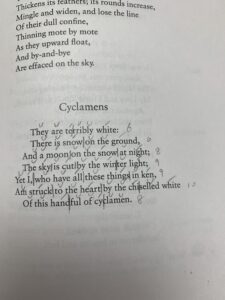Welcome back readers,
Some of you may think Elizabeth Barrott Browning is a tad dramatic. I like to think she’s emotional. But for the vast majority of people who read her poetry in the 18th-19th century, Browning was a passionate sensation and she was an outspoken advocate for reforming child labor. One of Browning’s most successful poems, “The Cry of the Children” is 13 stanzas with an ABAB rhyme scheme. Browning also utilizes assonance, metaphor, and imagery to force readers to come face to face with the poor child workers who are neglected and overworked as if they were mere pack animals. An even sadder reality is that a vast number of child workers even died from the extent of hard labor their underdeveloped bodies had to perform.
Readers, I would argue that assonance is the most dominant device here in Browning’s poem. Specifically, the assonance of long “ee” (“ye hear” [line 1], “weeping” [line 1], “bleating” [line 5], “leafless” [line 17], “see” [line 26], “seeking” [line 53], and etc.) and “uh” ( “brothers” [lines 1, 9, 21, 101, and 134], “mothers”[lines 3 and 23 ], “others” [lines 11 and 103] ). I believe one of the purposes of the assonance of such verbs, adjectives, and nouns emphasizes the voice of the speaker who is narrating the atrocities of child labor. In addition, the assonance places attention on certain words carrying emotional significance like “weeping” and “mothers”. I’m not entirely sure about this observation but does assonance also aid in denoting both the poem’s sorrowful mood and the pitiful imagery of the children?
Take a look at some of the imagery Browning uses: “The young lambs are bleating in the meadows, The young birds are chirping in the nest, The young fawns are playing with the shadows, The young flowers are blowing toward the west:” (lines 5-8) Is Browning asking us to imagine the children as symbols of innocence? Are these lines also meant to contrast and stress the following line “They are weeping in the playtime of the others,” (line 11)? That ALL young beings deserve to exist in bliss without experiencing unnecessary sorrow and hardship? This may be a far stretch but I also wonder if there’s a religious implication with this setting of nature and the symbolism of lambs, as if faith is absent for the children.
Sincerely,
Alucard

